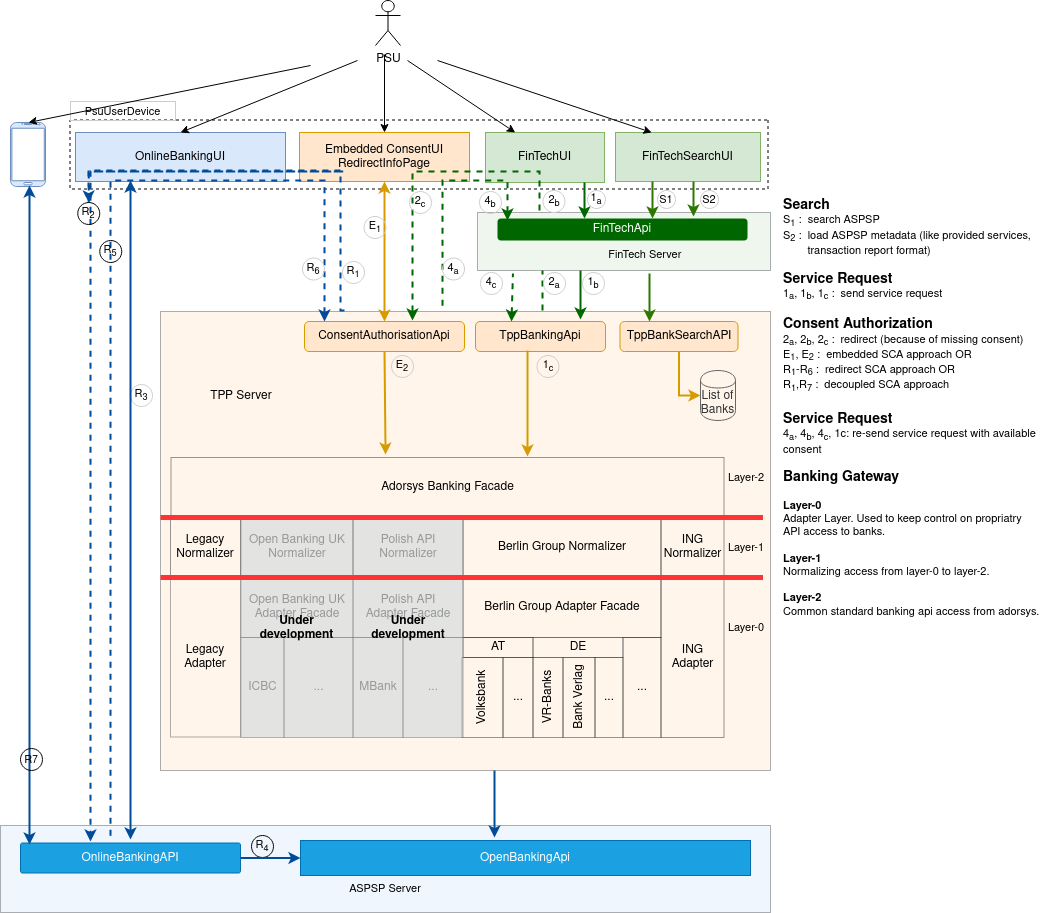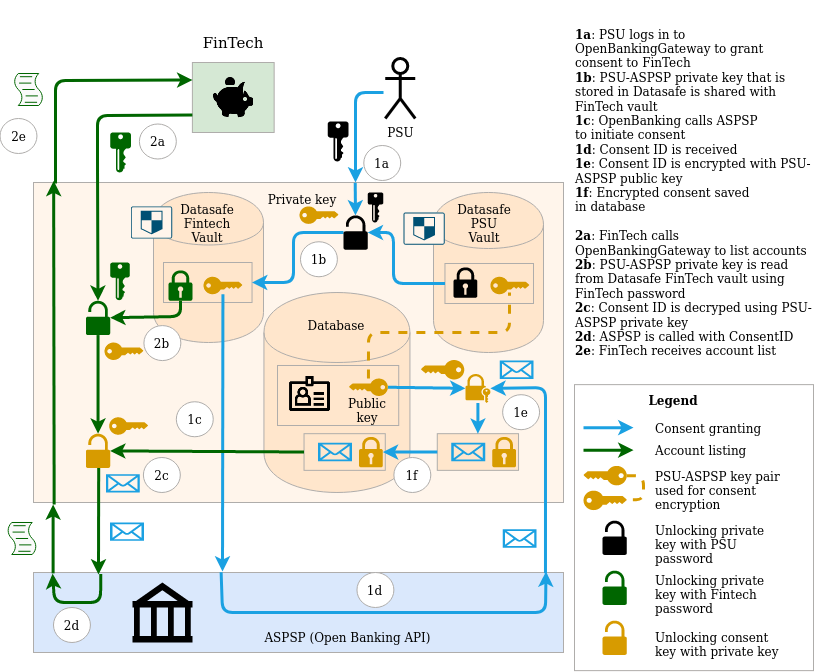Code coverage
Attention: this open-source project will change its licensing model as of 01.01.2022!
Constantly evolving and extending scope, production traffic and support in open banking world call for high maintenance and service investments on our part.
Henceforth, adorsys will offer all versions higher than v1.0 of Open Banking Gateway under a dual-license model. Thus, this repository will be available either under Affero GNU General Public License v.3 (AGPL v.3) or alternatively under a commercial license agreement.
We would like to thank all our users for their trust so far and are convinced that we will be able to provide an even better service going forward.
For more information, advice for your implementation project or if your use case requires more time to adapt this change, please contact us at psd2@adorsys.com.
For additional details please see the section FAQ on Licensing Change.
Provides tools, adapters and connectors for transparent access to open banking apis. The initial effort focuses on the connectivity to banks that implement the European PSD2 directive either through one of the common market initiatives like : The Berlin Group NextGenPSD2, The Open Banking UK, The Polish PSD2 API or even through proprietary bank api like the ING’s PSD2 API.
The European PSD2 as the first regulator driven Open Banking initiative offers many opportunities for both banks, known as traditional provider of payment services (called ASPSPs in this context) and other Third Party Providers of payment services (TPPs). TPPs can use account information and payment services provided by banks to offer new innovative services to bank account holders. The more banks and TPPs can interact with each other, the more payment account holders can be provided with reacher banking solutions, which in turn simplifies and leverage commercial value chains.
Being able to interact with different banking APIs can be a time and cost consuming challenge. Even though the PSD2 requires European banks to provide APIs and despite the effort of market initiatives to provide common standard interfaces, there is still a multitude of divergent authorization schemes involved and a lot of space for implementation options. A bank can even decide not to join one of the known market initiatives and define it's own PSD2 compliant API.
The purpose of this open banking gateway is to provide the community with a common and simple interface for accessing major Open Banking APIs.
Being a regulator driven initiative, PSD2 mandates the regulation of TPPs. With this additional detail, the market is experiencing a distinction between regulated TPPs and non regulated FinTechs. This framework is therefore designed taking in consideration the existence of the category of payment service providers called FinTech that used APIs exposed by a regulated TPP to access payment services exposed by banks.
In the Open Banking Context, a payment service user (PSU or banking account holder) might have to deal with up to 3 different user interface to initiate, authorize and get the requested banking service executed. There being redirected back and forth from one UserAgent (resp. device) to another. This intensive use of redirection in Open Banking bearing a lot of risk of impersonating the PSU, we set a goal of this Framework to dissect the complexity involved with those redirection processes and open forums for discussion of possible solutions and sample implementations. Following papers are the first attempt to capture the problem (UserAgent Redirection, PSU Access Security Design).
The following picture displays the overall architecture of this banking gateway:

The following picture displays the overall security concept of this banking gateway:

Security concept has 2 kinds of flows:
- authenticated (for consent sharing)
- anonymous (for payments, but can be authenticated too).
Here are detailed diagrams of each flow:
The following picture displays the overall technical architecture concept of this banking gateway:
Key components as shown on diagram:
APIs:
- Banking API and its implementation Banking API Impl
- Consent API and its implementation Consent API Impl
Facade:
Protocol:
- docker-compose-dev.yml - docker-compose file in the project root for Development (requires building docker images)
- docker-compose.yml - docker-compose file in the project root for Demo (Images will be pulled from DockerHub)
- postman-collections
- postman-environments (for playing use this Postman environment)
- postman-ais-collection Xs2a-embedded or HBCI AIS (account information services) example - getting users' account and transactions list
Note: Postman requires disabled request signing functionality - for that use Spring-profile no-signature-filter.
You can use our DEV environment (without signature check) if you import this Postman environment
-
Working with BPMN: As most protocols use BPMN, we have developed the plugin 'Flowable BPMN visualizer' that directly integrates into IntelliJ with code navigation, refactoring and other stuff for Flowable BPMN engine. It will make your work a lot easier as you don't need to leave IntelliJ to change diagram or to see what class is used at which step.
-
Running local tests faster. To avoid Postgres TestContainer slow initialization one can use following environment variables:
TESTCONTAINERS_REUSE_ENABLE=true;TESTCONTAINERS_RYUK_DISABLED=true;SPRING_DATASOURCE_URL=jdbc:tc:postgresql:12:////open_banking?TC_DAEMON=true&?TC_TMPFS=/testtmpfs:rw&TC_INITSCRIPT=init.sql&TC_REUSABLE=truethis will keep Postgres TestContainer started and migrated after 1st run, significantly reducing next tests startup time. Note, that it will introduce shared state across tests, which is mostly OK but for some tests may cause failures. -
Starting with project: How to start with project
-
Populating database with bank data: How to fill database with bank data
Please take a look into our documentation to know more about:
- Dictionary
- Use Cases
- Banking Protoсol Design
- User Agent Redirection
- PSU Access Security Design
- JavaDoc
This project is designed to enable contribution from different sources, as the open banking challenge will start with a magnitude of discrepancies in individual bank implementations, even for banks implementing a common standards.
- Francis Pouatcha - Initial work - adorsys
See also the list of contributors who participated in this project.
For commercial support please contact adorsys Team.
This project is dual licensed under Affero GNU General Public License v.3 (AGPL v.3) or alternatively under a commercial license agreement - see the LICENSE file for details.
For commercial inquiries please contact us at psd2@adorsys.com.
For additional details please see the section: FAQ on Licensing Change.
Under a dual-licensing model, our product is available under two licenses:
- The Affero GNU General Public License v3 (AGPL v3)
- A proprietary commercial license
If you are a developer or business that would like to review our products in detail, test and implement in your open-source projects and share the changes back to the community, the product repository is freely available under AGPL v3.
If you are a business that would like to implement our products in a commercial setting and would like to protect your individual changes, we offer the option to license our products under a commercial license.
This change will still allow free access and ensure openness under AGPL v3 but with assurance of committing any alterations or extensions back to the project and preventing redistribution of such implementations under commercial license.
Will there be any differences between the open-source and commercially licensed versions of your products?
Our public release frequency will be reduced as our focus shifts towards the continuous maintenance of the commercial version. Nevertheless, we are committed to also provide open-source releases of our products on a regular basis as per our release policy.
For customers with a commercial license, we will offer new intermediate releases in a more frequent pace.
No, the product will still be published and available on GitHub under an OSI-approved open-source license (AGPL v3).
What about adorsys’ commitment to open source? Will adorsys provide future product releases on GitHub?
We at adorsys are committed to continue actively participating in the open-source community. Our products remain licensed under OSI-approved open-source licenses, and we are looking forward to expanding our product portfolio on GitHub even further.
All currently published versions until v1.0 will remain under their current Apache 2.0 license and its respective requirements and you may continue using it as-is. To upgrade to future versions, you will be required to either abide by the requirements of AGPL v3, including documenting and sharing your implemented changes to the product when distributing, or alternatively approach us to obtain a commercial license.
We understand that adjustment to licensing changes can take time and therefore are open to discuss extension options on an individual basis. For inquiries please contact us at psd2@adorsys.com.
All versions of Open Banking Gateway after v1.0 will be affected by the licensing changes and move to a dual-licensing model.
All older Apache 2.0 licensed versions prior and including v1.0 will remain available under their existing license.
The following products are affected:
I’m using one of these products indirectly via some software integrator. How does the licensing change affect me?
The licensing change does not affect you as user, but it is relevant to your provider who has used our product in their solution implementation. In case of uncertainty please contact your service provider or approach us at psd2@adorsys.com.
